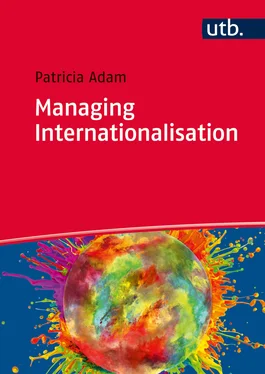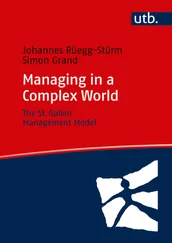| 3.2 |
Developing the Mission, Vision, Values and Ethics |
| 3.2.1 |
Defining and Communicating the Core Purpose of an Organisation |
|
VIPs |
| 3.2.2 |
Acting as Role Models for Ethical Behaviour |
| 3.2.2.1 |
Corporate Ethics and Social Responsibility |
| 3.2.2.2 |
Ethical Behaviour in International Business |
|
VIPs |
| 3.2.3 |
Communicating Direction and Uniting the Organisation’s People |
| 3.2.5 |
Developing and Reviewing Leadership Culture |
| 3.2.5.1 |
Developing and Supporting a Shared Leadership Culture |
| 3.2.5.2 |
Reviewing and Improving Leadership Behaviour |
|
VIPs |
| 3.3 |
Driving Performance and Engaging with External Stakeholders |
| 3.4 |
Reinforcing a Culture of Excellence |
| 3.4.1 |
Developing an Excellent Organisational Culture |
| 3.4.2 |
Promoting and Encouraging Diversity |
|
VIPs |
| 3.5 |
Managing Change |
|
VIPs |
| 3.6 |
Citations & Notes |
| 4 |
Defining and Delivering an International Strategy |
| 4.1 |
Strategy and the Strategy Management Process |
| 4.1.1 |
Popular Strategy Definitions |
| 4.1.2 |
Comprehensive Strategy Management Processes: EFQM Criterion 2 |
| 4.2 |
Scanning the Environment |
| 4.2.1 |
Understanding the Needs and Expectations of Stakeholders |
| 4.2.2 |
Analysing Industry and Markets |
| 4.2.3 |
Identifying and Understanding Environmental Key Trends |
| 4.2.4 |
Predicting Future Developments and Changes |
|
VIPs |
| 4.3 |
Analysing Internal Performance |
| 4.3.1 |
Understanding Operational Performance and Capabilities |
| 4.3.2 |
Determining Competencies of Partners and Potential Impacts of Changes. |
| 4.3.3 |
Bringing It All Together: Portfolios |
|
VIPs |
| 4.4 |
Developing the Strategy |
| 4.4.1 |
Strategy Levels |
| 4.4.2 |
Generating a Sustainable Business Model |
| 4.4.3 |
Business Model Choices |
| 4.4.4 |
Establishing a Strategy Development Process |
|
VIPs |
| 4.5 |
Communicating and Implementing the Strategy |
| 4.6 |
Citations & Notes |
| 5 |
Deploying Strategy through People |
| 5.1 |
International Human Resource Management |
| 5.1.1 |
The International HRM Function |
| 5.1.2 |
Managing People: EFQM Criterion 3 |
| 5.2 |
Supporting the Strategy through People Plans |
| 5.2.1 |
Steering Human Resource Management Strategically |
|
VIPs |
| 5.2.2 |
Planning Global Mobility |
|
VIPs |
| 5.2.3 |
Closing the Loop: People Feedback |
|
VIPs |
| 5.3 |
Developing People and Their Performance |
| 5.3.1 |
Developing People’s Skills and Competencies |
|
VIPs |
| 5.3.2 |
Helping People to Improve Their Performance |
|
VIPs |
| 5.3.3 |
Appraising Performance Systematically |
| 5.3.4 |
Empowering and Involving People |
|
VIPs |
| 5.4 |
Communicating Effectively |
|
VIPs |
| 5.5 |
Recognising People |
|
VIPs |
| Citations & Notes |
| 6 |
Managing International Partners and Resources |
| 6.1 |
A Broad View on Resources: EFQM Criterion 4 |
| 6.2 |
Establishing International Partnerships for Mutual Benefit |
| 6.2.1 |
Selecting an Appropriate Foreign Operation Mode |
| 6.2.1.1 |
Cross-Border Strategic Alliances |
|
VIPs |
| 6.2.1.2 |
Contractual Agreements in International Operations |
| 6.2.1.3 |
International Joint Ventures |
| 6.2.1.4 |
Mergers & Acquisitions across Borders and Cultures |
| 6.2.2 |
Managing International Partners |
|
VIPs |
| 6.3 |
Managing Finance and Governance Processes |
| 6.3.1 |
Optimising Organisational Financial Management |
|
VIPs |
| 6.3.2 |
Ensuring Compliance |
|
VIPs |
| 6.3.3 |
Managing Risks |
|
VIPs |
| 6.4 |
Managing Knowledge and Information |
| 6.4.1 |
Managing Knowledge Systematically |
|
VIPs |
| 6.4.2 |
Establishing Integrated (Management) Information Systems |
| 6.5 |
Citations & Notes |
| 7 |
Managing Processes and Products Globally |
| 7.1 |
Delivering Stakeholder Value: EFQM Criterion 5 |
| 7.2 |
Managing Processes |
|
VIPs |
| 7.3 |
Managing Products and Services Based on ISO 9001 |
| 7.3.1 |
Introducing a Certifiable Quality Management System |
|
VIPs |
| 7.3.2 |
Managing Products and Services Globally |
|
VIPs |
| 7.3.3 |
Enhancing Customer Relationships |
| 7.4 |
Citations & Notes |
| 8 |
Achieving and Monitoring Balanced Results |
| 8.1 |
EFQM Results Criteria |
| 8.2 |
Introducing the Balanced Scorecard Concept |
|
VIPs |
| 8.3 |
Monitoring Achievements by Designing Meaningful Dashboards |
|
VIPs |
| 8.4 |
Citations & Notes |
| 9 |
Assessing the Organisation’s Management Model |
| 9.1 |
Establishing Strategy Reviews for Continuous Improvement |
|
VIPs |
| 9.2 |
Implementing Self-Assessments |
| 9.2.1 |
Introducing Self-Assessment Tools |
|
VIPs |
| 9.2.2 |
Conducting a Simulated Award Assessment |
|
VIPs |
| 9.3 |
Achieving External Recognition and Winning Excellence Awards |
|
VIPs |
| 9.4 |
Citations & Notes |
References
List of Abbreviations
Glossary
Index
Table of Figures
| Figure 1-1 |
Concept Map “Introduction and Overview” |
| Figure 1-2 |
Symbols Used for Special Information Employed Throughout this Book |
| Figure 1-3 |
Multi-Faceted Motives for Internationalisation Processes |
| Figure 1-4 |
The Global Integration/Local Responsiveness Framework |
| Figure 1-5 |
Survey of the New St. Gallen Management Model |
| Figure 1-6 |
Baldrige Criteria for Performance Excellence Framework 2015 |
| Figure 1-7 |
Читать дальше












